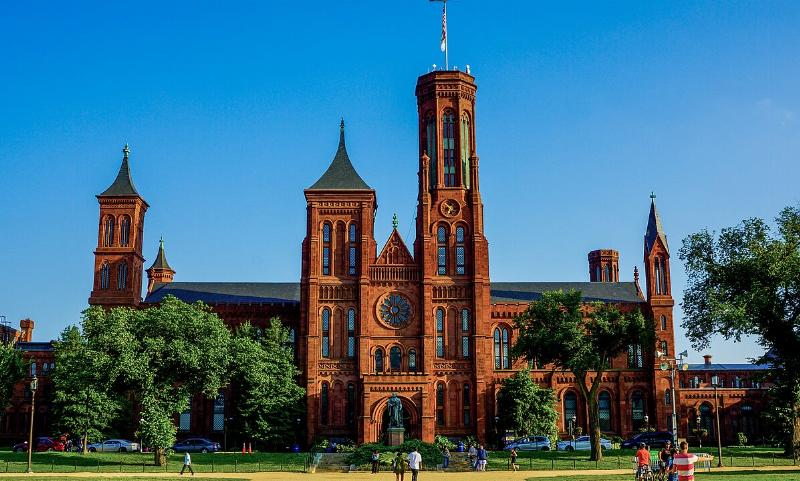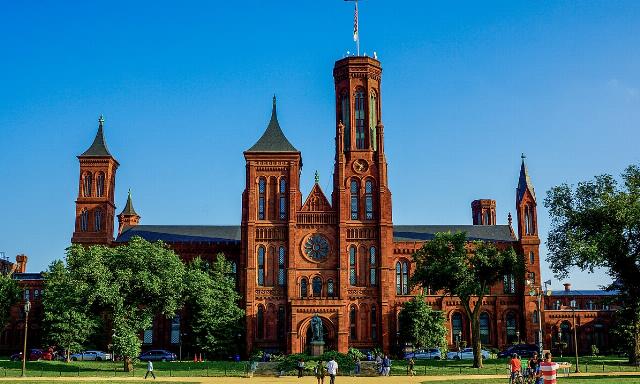


Once affectionately known as “America’s attic,” the Smithsonian has for years been a steaming heap of leftism, and it’s only getting worse. The Trump administration is calling out, though, something that’s entirely appropriate given its latest exhibition, which was obviously curated by an Ivy League colonial studies department.
The Smithsonian’s collection began in 1816 when the Columbian Institute for the Promotion of Arts and Sciences was founded, with the stated purpose of “forming an association for promoting useful knowledge,” which then meant scientific knowledge. Early members were John Quincy Adams and Andrew Jackson, and four Founding Fathers—Madison, Monroe, Adams, and Jefferson—were named as honorary members.

Image by Nate Lee. CC BY-SA 4.0.
When the Columbian Institute’s charter expired, the scientific collection passed to a reconstituted entity called the National Institution, founded in 1840, again with the goal of creating a repository of scientific information.
Meanwhile, the state of a wealthy British scientist named James Smithson eventually passed in 1835 “to the United States of America, to found at Washington, under the name of the Smithsonian Institution, an Establishment for the increase & diffusion of knowledge among men.” The bequest totaled between $15,000,000 and $200,000,000 in today’s dollars, depending on how one calculates it.
The old National Institution was then folded into the new Smithsonian, and that is how today’s multi-building and -collection museum came into being. Because of federal ownership, the new museums saw it morph from an institution dedicated to accruing scientific wisdom to a repository of Americana. Over the years, the enterprise has added the following museums (listed in the order in which they were added):
As you can see, over the years, the museum devolved from celebrating Americana (subject to a few bequeathed collections, such as the African Art Museum) to celebrating subsections of America. The melting bowl was devolving into a multicultural nightmare. That trend continues with two planned new museums: the National Museum of the American Latino and the Smithsonian American Women’s History Museum.
The problem with museums today is that the curators are all college graduates. This means that they are, probably without exception, leftists, and they have been this way for a long time. In 1995, the Museum commemorated World War II’s end—thanks to the atomic bomb that prevented possibly 100,000 American troop deaths and as many as a million Japanese dead and wounded—by framing it as a genocidal event.
When I was at the Smithsonian in 2004 or 2005, the museum was obsessed with America as a racist country. However, by 2016, the institution had its own problem with racism when the African American History and Culture Museum prominently ignored Clarence Thomas for being the wrong kind of African American. By 2020, the museum was engaged in open racism against white people.
And naturally, the Smithsonian was all in on climate change.
You would think that, with this history, I wouldn’t be surprised at what the Smithsonian’s college-educated curators would come up with next, but never say never. This time around, it’s got a “colonial studies” take on American popular culture that denigrates everything that ordinary Americans of all races, colors, and creeds once enjoyed:
One placard, featured alongside a 1923 circus poster, reads: “Under the big top, circuses expressed the colonial impulse to claim dominion over the world.” Another, describing early American entertainment, declares: “One of the earliest defining traits of entertainment in the United States was extraordinary violence.”
The exhibit reframes iconic American characters through a critical, politically-charged lens. On The Lone Ranger, the display states: “The White title character’s relationship with Tonto resembled how the U.S. government imagined itself the world’s Lone Ranger.”
Mickey Mouse, a beloved American cultural icon, is not spared either. A display for the 1928 cartoon Steamboat Willie states, “Mickey challenged authority, but not everyone was in on the joke.”
It continues: “Mickey Mouse debuted as the deckhand ‘Steamboat Willie’ in 1928, amidst a rising anxiety felt by many that modern living and city life were eroding family and community ties and loosening moral codes… But the new character’s outsized facial features, white gloves, and trickster temperament were vestiges of longstanding traditions of blackface minstrelsy.”
In reference to the Indiana Jones film series, another panel reads: “His character embodied a confident righteousness that, in many ways, captured the essence of the 1980s” above another subhead referencing President Ronald Reagan’s famous speech, asking, “Are you better off?”
One panel calls Magnum, P.I. a challenge to the “popular perceptions of Vietnam veterans as damaged misfits.” A section on Jon Stewart’s Daily Show refers to it as “the go-to for viewers who mistrusted politicians and the reporting process.”
Meanwhile, the Smithsonian board was boasting less than a month ago that it would keep the Smithsonian “free from political or partisan influence.”
The institution that was developed to celebrate wisdom and America is now bogged down in stupidity and hatred for America and Americans. By the way, it receives almost a billion annually from the American taxpayers.
The Trump administration, however, is working to bring the Smithsonian’s rampant leftism to heel. It fired National Portrait Gallery Director Kim Sajet, and has accused the Smithsonian (quite rightly, in my opinion) of promoting “one-sided, divisive political narratives” that are at odds with celebrating America.
I wish the administration all the luck in the world. The Smithsonian’s collection is extraordinary. In the hands of a curator who truly loves America, it could and should be a wonderful institution that celebrates the greatness of a country that, while imperfect (as are all human institutions), is still the best, freest, and most generous and prosperous country human beings have ever devised.
